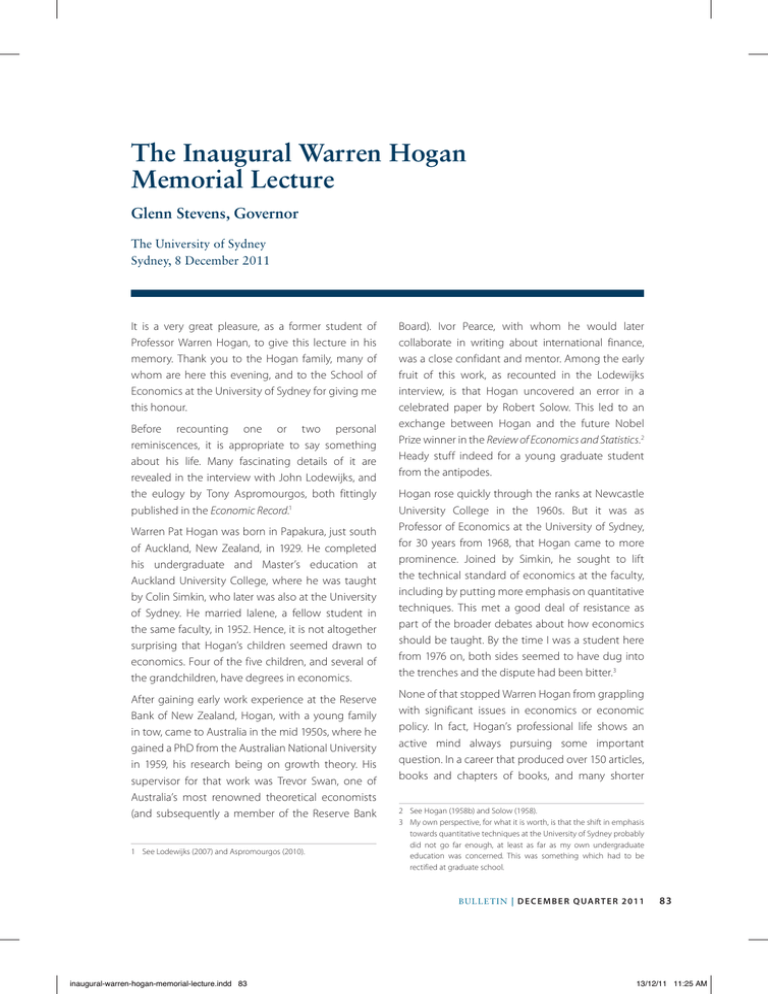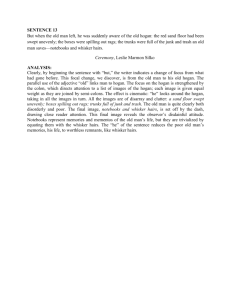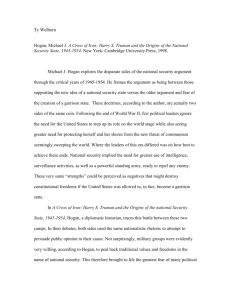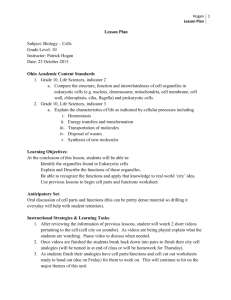The Inaugural Warren Hogan Memorial Lecture Glenn Stevens, Governor The University of Sydney
advertisement

The Inaugural Warren Hogan Memorial Lecture Glenn Stevens, Governor The University of Sydney Sydney, 8 December 2011 It is a very great pleasure, as a former student of Professor Warren Hogan, to give this lecture in his memory. Thank you to the Hogan family, many of whom are here this evening, and to the School of Economics at the University of Sydney for giving me this honour. Before recounting one or two personal reminiscences, it is appropriate to say something about his life. Many fascinating details of it are revealed in the interview with John Lodewijks, and the eulogy by Tony Aspromourgos, both fittingly published in the Economic Record.1 Warren Pat Hogan was born in Papakura, just south of Auckland, New Zealand, in 1929. He completed his undergraduate and Master’s education at Auckland University College, where he was taught by Colin Simkin, who later was also at the University of Sydney. He married Ialene, a fellow student in the same faculty, in 1952. Hence, it is not altogether surprising that Hogan’s children seemed drawn to economics. Four of the five children, and several of the grandchildren, have degrees in economics. After gaining early work experience at the Reserve Bank of New Zealand, Hogan, with a young family in tow, came to Australia in the mid 1950s, where he gained a PhD from the Australian National University in 1959, his research being on growth theory. His supervisor for that work was Trevor Swan, one of Australia’s most renowned theoretical economists (and subsequently a member of the Reserve Bank 1 See Lodewijks (2007) and Aspromourgos (2010). Board). Ivor Pearce, with whom he would later collaborate in writing about international finance, was a close confidant and mentor. Among the early fruit of this work, as recounted in the Lodewijks interview, is that Hogan uncovered an error in a celebrated paper by Robert Solow. This led to an exchange between Hogan and the future Nobel Prize winner in the Review of Economics and Statistics.2 Heady stuff indeed for a young graduate student from the antipodes. Hogan rose quickly through the ranks at Newcastle University College in the 1960s. But it was as Professor of Economics at the University of Sydney, for 30 years from 1968, that Hogan came to more prominence. Joined by Simkin, he sought to lift the technical standard of economics at the faculty, including by putting more emphasis on quantitative techniques. This met a good deal of resistance as part of the broader debates about how economics should be taught. By the time I was a student here from 1976 on, both sides seemed to have dug into the trenches and the dispute had been bitter.3 None of that stopped Warren Hogan from grappling with significant issues in economics or economic policy. In fact, Hogan’s professional life shows an active mind always pursuing some important question. In a career that produced over 150 articles, books and chapters of books, and many shorter 2 See Hogan (1958b) and Solow (1958). 3 My own perspective, for what it is worth, is that the shift in emphasis towards quantitative techniques at the University of Sydney probably did not go far enough, at least as far as my own undergraduate education was concerned. This was something which had to be rectified at graduate school. B U L L E TIN | D E C E M B E R Q UA R T E R 2011 inaugural-warren-hogan-memorial-lecture.indd 83 83 13/12/11 11:25 AM T H E I NAUG URA L WA RRE N H O G A N M E M O RIAL L E C TU R E publications, he ranged broadly. As early as 1958 he was producing articles examining the rise of new financial intermediaries outside the regulated banking system – a theme about which we were still hearing in the 1980s, and one which should resonate today in light of the attention being given to ‘shadow banks’ and the expansion of the weight and width of the global regulatory footprint currently under way.4 Hogan retained an interest in both financial regulation and deregulation throughout his career, and married this with a nuanced understanding of the behaviour of financial players in their appetite for risk. Hogan also worked on issues of development in the emerging world, wages, immigration and transport. He served as economic adviser to one Federal Treasurer (Lynch) and as a director of various companies, most notably serving on Westpac’s Board for 15 years, including through the period of deregulation and subsequent tumult. In his later years he conducted a major review of pricing in aged care. He also served in numerous capacities over the years in various university administrative positions and on other committees in the broader community. His was a full life indeed. It was in my third year at Sydney University that I think I first encountered Professor Hogan. This would have been in 1978. More than three decades after I sat in afternoon seminars conducted by him, the memories of his general style are clearer than the things he actually said. He was usually dressed in a suit – which would have been much more unusual for an academic in the late 1970s than it is now. The reason was perhaps that he had been in the city earlier in the day as he was active in dealing with practical policy issues and had links with the business world. On days when there might have been a nice business lunch, there was a certain relaxed expansiveness to his demeanour. He spoke often without notes on whatever economic topic we were covering, and as he spoke he would take the various coins from his pocket and arrange them 4 See Hogan (1958a). 84 into small piles on the table. We wondered what subconscious portfolio balance idea might have been behind that behaviour. Warren often had a somewhat elliptical way of saying things – you had to listen carefully to get what he may have really been saying, and sometimes you weren’t sure you had understood correctly. As I reflect now on this characteristic, I wonder whether he missed a calling as a central banker! He certainly had built up contacts in the central banking world, as an occasional visitor to the BIS, where he was on very good terms with the late Palle Schelde Andersen, a renowned BIS economist and student of the international economy and financial system. I assume that their acquaintance was made in the late 1970s, when Andersen visited the University of Sydney for a period, funded by a grant from the Reserve Bank.5 One Hogan paper of that era that really struck a chord with me then – I have always recalled its title – was about the issue of revisions to economic statistics. It was entitled ‘How Do We Know Where We Are Going, When We Don’t Know Where We Have Been, Let Alone Where We Are?’.6 These days the study of revisions to data is an art in itself (though the quality of national accounts data is better than it was in the 1970s). Central banks put huge effort into what has come to be called ‘nowcasting’ – that is, working out what the national accounts probably will, or should, say about the current quarter in three or four months’ time when they are released. Some central banks actually ‘backcast’ the recent past, deciding their own version of GDP, not necessarily the same as the one published by the statisticians, in effect foreshadowing revisions to come.7 The RBA has not gone to that extent, though of course we have seen certain difficulties in assessing the current 5 Hogan was at the conference in Basel to honour Palle Schelde Andersen’s professional life in December 2007. 6 See Hogan (1978). 7 For example, the Bank of England’s (BoE) Monetary Policy Committee, for some time, has been presented with output growth numbers that contain various adjustments by the BoE’s staff. For more information, see Cunningham and Jeffery (2007). R ES ERV E B A N K O F AUS T RA L I A inaugural-warren-hogan-memorial-lecture.indd 84 13/12/11 11:25 AM TH E IN AU GU R AL WAR R E N H O GAN ME MO R IAL L E C TU R E pace of underlying inflation in our own country over recent months, with reasonably significant revisions to some data series. So Hogan was on to something here – as far back as 1978. But the work on which I wish to focus for a brief period tonight is the book Hogan co-authored with Ivor Pearce entitled The Incredible Eurodollar.8 Published first in 1982, with subsequent editions published in 1983 and 1984, this fascinating little book sought to explain the workings of the Eurodollar market and the institutions which operated in it. In the 1970s – the dataset on which Hogan and Pearce based their work – the Eurodollar markets were an exotic new development, spawned by a period of international financial turmoil and innovation, some of which was in response to regulation. The post-World War II compact known as the Bretton Woods system had held for about 20 to 25 years. This involved a US dollar standard, under which countries fixed, and occasionally adjusted, their exchange rates to the US dollar; the dollar was fixed to gold at US$35 per ounce; private capital flows were limited in scope; and official flows made major contributions, via the IMF, to international adjustment. But by the late 1960s and early 1970s, this arrangement had come under severe strain as private capital flows began to increase in size and US policymakers found they could not live with the constraints of the system. In a sequence of events, including the break of the link with gold and the decision by key countries to allow their currencies to float against the dollar, the system broke down. The result was a system in which exchange rates between the then major currencies have floated, with occasional efforts at management, ever since. 8 In choosing this work for more detailed consideration, I am conscious of the question: was it more Hogan’s work or Pearce’s? Certainly Pearce had already released a piece by that name (Pearce 1980). But equally Hogan was clearly a student of financial intermediaries and markets from early in his career, and released two working papers on Eurofinance markets in 1979 (Hogan 1979a, 1979b). No doubt he and Pearce had exchanged views on such issues over time, particularly during Hogan’s visit to the University of Southampton in 1979. My assumption is that the book published as Hogan and Pearce (1982) was a genuinely collaborative effort. The Eurodollar Market was in essence a pool of obligations issued by banks outside the US jurisdiction but denominated in dollars. It grew rapidly, apparently unconstrained by regulation conducted on a national basis (as all regulation was, and largely still is). It was part of a large increase in cross-border financing activity by internationally active banks. When Hogan and Pearce published their third edition in 1984, the stock of cross-border assets held by BIS reporting banks was about US$2 trillion. Today, it is around US$32 trillion. In the early 1980s, much of the talk about the Eurodollar Market was couched in terms of whether Eurodollar deposits should be added to measures of the money stock, which were the height of economic fashion at the time. As you will recall, this was the period in which the US Federal Reserve targeted monetary aggregates explicitly and in which weekly monetary aggregates data were scrutinised closely for signs about the likely direction of US interest rates. One can see this background quite clearly in Hogan and Pearce’s little book, which has lots of discussion about whether Eurodollar deposits are ‘money’ (they thought not) or just ‘debt’ (they thought so). It was only a few years later that most countries gave up the effort to define ‘money’ and to conduct their policy discussion in terms of money aggregates, instead going back to the former model of setting a short-term interest rate. It is interesting, though, that in recent years the ‘zero lower bound’ for nominal interest rates, which as students we would have been taught about as ‘the liquidity trap’, is no longer a curiosity in the textbook from a bygone era, but has actually been binding in several major countries. One implication, among others, has been that calibrating monetary policy in terms of monetary quantities has come back into vogue in some places – this time with the relevant central banks consciously seeking to increase the size of their balance sheets. Whether the relationship between ‘money’ and nominal GDP or prices has become any more reliable than it was 25 years ago, when it was B U L L E TIN | D E C E M B E R Q UA R T E R 2011 inaugural-warren-hogan-memorial-lecture.indd 85 85 13/12/11 11:25 AM T H E I NAUG URA L WA RRE N H O G A N M E M O RIAL L E C TU R E found too fluid to be useful for policy purposes, is not clear. But if the language in Hogan and Pearce’s early 1980s work is, perhaps, a product of its times, some of the observations are astute, and there are some quite prescient insights. To begin with, Hogan and Pearce note that the activities of Eurocurrency markets – and we could generalise this to cross-border private financing generally – lessened the pressure on countries to adjust to current account imbalances, especially on the deficit side. This could be seen as good – allowing capital to flow more efficiently to the locations offering the highest risk-adjusted return. Or it could be worrying: the markets giving a nation more rope, so to speak, by allowing current account balances to become larger and more persistent than they would otherwise. Remember that at the time they wrote, current account positions had rarely been more than a few percentage points of GDP for any length of time, at least since 1945. The analysis of the mythical planet Htrae, with three countries Surplusia, Deficitia and Balancia, with respective currencies Surps, Defs and Bals, focuses on the operation of markets and, importantly, the role of financial institutions as intermediaries between savers in one country and borrowers in another. In the language of more recent times, financial institutions are key to the dynamics of so-called ‘global imbalances’. Indeed, Hogan and Pearce state, rather bluntly: ‘Financial intermediaries live upon imbalances’.9 At one level that is obvious – financial intermediaries or markets exist to transfer resources from savers to borrowers (and back again), which is to say that an imbalance between saving and investment at the level of an individual household or firm in the economy is matched against an equivalent imbalance of opposite sign in some other firm or household. The deeper sense in which this ‘thriving’ takes place in an international setting is that savers in one country lend their money 9 See Hogan and Pearce (1984, p 60). 86 to borrowers in another jurisdiction, about whom they know next to nothing, but feel safe in doing so because what they hold directly is an obligation of a large, well-known, globally active bank, assumed to be safe. But as Hogan and Pearce point out, a European entity raising dollars to fund a balance sheet does not have automatic access to a lender of dollars of last resort in the event that market conditions change. It is therefore exposed to serious funding risk in a way that does not occur in purely local currency operations. The average ‘Eurobank’ in the early 1980s had access to marks or francs – today euros – or pounds from its national central bank, but it could not be assumed that in times of stress these currencies could necessarily easily be swapped for dollars. In fact, this very phenomenon was at the heart of the crisis that began to unfold in 2007. It was in Europe, where banks had, and still have, a structural need for dollar borrowing to fund US dollar denominated assets, that the market strains first appeared in August 2007. As the crisis intensified, the need for access to central bank funding in dollars required a number of central banks to enter into swap arrangements with the US Federal Reserve so their domestic banks could borrow US dollars secured by local currency collateral. European banks were by far the largest users of these facilities – about US$400 billion was accessed via the ECB and other central banks in Europe at the peak in December 2008. Of course, it is also in Europe that we have seen the epicentre of the most recent stage of the crisis. In some other respects, today’s problems are a little different, and perhaps more complex, from those of three years ago. They arise from cross-border lending within a currency area that has a single money but very divergent experiences in terms of fiscal discipline and productivity, and that lacks a well-developed capacity for intra-area transfers – which is being built as we speak. Nonetheless, dollar funding for European banks has again tightened up and the swap lines among major central banks have R ES ERV E B A N K O F AUS T RA L I A inaugural-warren-hogan-memorial-lecture.indd 86 13/12/11 11:25 AM TH E IN AU GU R AL WAR R E N H O GAN ME MO R IAL L E C TU R E again been activated to assist. This is presumably designed to slow the speed of European bank deleveraging of dollar assets that would otherwise be forced to occur. Lots of people claim to have predicted the crisis, though I doubt that Warren Hogan, were he here, would claim that he and Ivor Pearce foresaw it in all its dimensions almost 30 years ago. I think they would perhaps claim that their saga of Htrae, where international cross-border financing ultimately produced a crisis, contained many relevant insights. I doubt that they fully appreciated the role that the financial institutions of the leading deficit country – the United States – would play in creating risk and transferring it elsewhere. In their story, the key institutions were those of the country of Balancia, where the international accounts initially were balanced. I think they would have expected the response of major central banks to the crisis to have resulted in more inflation than it has, so far. That may be a reflection of the inflationary times in which they were writing – when it seemed almost inconceivable that deflationary problems akin to the 1930s could re-emerge. The example of Japan, where there has been deflation for well over a decade, had not yet occurred in 1982. Of course, they might just have expected the inflation still to be coming. They would not be alone in that view. It is certain though that Hogan would have been watching all these developments with close interest. He would have been recognising certain things that he could have broadly predicted, and I suspect he would have said so with that very dry turn of phrase he had. He would also, surely, have been observing things that would have surprised him, and he would have been thinking about how his view of the world needed revision. He would have been pondering the future of the international financial system. In that vein, I shall use the remainder of the time this evening to make a few observations in that area. The first is that there is an extensive program of regulatory reform under way. In an international setting potentially the most far-reaching is the set of proposals recently endorsed at the G-20 summit to mitigate the problems posed by institutions that are too big to fail at an international level, otherwise known as Globally Systemically Important Financial Institutions, or G-SIFIs. Some 29 individual banks have been identified as fitting the criteria to be labelled G-SIFIs at present, though the list is not a fixed one: banks can enter and leave it over time. There will, in due course, be a framework for globally systemic insurance companies with parallel criteria. The intention of the policy is to make the failure of such entities less likely by requiring additional capital, and to make the consequences of failure less dramatic by developing better tools to resolve entities that have failed or are on the point of failure. The latter, in particular, is a very ambitious undertaking and contains some potentially far-reaching components – such as the ability to ‘bail in’ certain creditors to an institution on the point of failure, effectively turning them into shareholders, so as to lessen the likelihood that taxpayers will be called upon in such a situation. To make it work would require considerable co-operation across jurisdictions at moments where everyone’s instinct is to protect creditors and counterparties in their own jurisdiction. I don’t know what Hogan would have made of this. I suspect he would be wondering whether, if regulatory actions bind on one group of institutions, the behaviour in question would end up migrating to other, less-regulated places. This possibility is understood by the international regulatory community, which also has a regulatory agenda for ‘shadow banking’. This is actually a critical point. I would offer the observation that, if we can get through the next year or so without a major crisis and successfully implement the various reforms – which might both be big ‘ifs’ – the next financial crisis may not occur in the same sorts of institutions as last time (or this time), but in different ones. It could well occur in institutions or markets that do not as yet exist. B U L L E TIN | D E C E M B E R Q UA R T E R 2011 inaugural-warren-hogan-memorial-lecture.indd 87 87 13/12/11 11:25 AM T H E I NAUG URA L WA RRE N H O G A N M E M O RIAL L E C TU R E The key thing in avoiding disastrous crises in the future is less the specifics of regulation or resolution – as important as these are – than having a clear understanding of the nature and extent of risk-taking behaviour, in all its potential dimensions and locations. On my reading of Hogan’s work, I believe he would have shared this view. Put in the simplest of terms, we might ask: where are financiers apparently making easy money? In what area of risktaking are the profits large or expected to be large? There is a good chance that it is there that, given enough time, the likelihood of excesses is greatest. In Hogan and Pearce’s book, financial institutions and their behaviour were seen as central to the build-up of imbalances. But they are in one sense merely facilitating flows of capital that are reflective of other phenomena, resulting from the collective behaviour of the actors in surplus and deficit countries. So in contemplating the future of the international financial system, reforming the regulation of financial institutions, and understanding their behaviour, will be key, but it will be of equal importance to understand the underlying behaviour of the entities in the real economies. The role of official capital flows, in particular, is one element of the post-crisis world that seems to be becoming quite prominent. Indeed, perhaps one of the most striking features of the international financial system is the size of official reserve assets that have been accumulated by what Hogan and Pearce would have labelled ‘Surplusia’ – the countries that have run persistent current account surpluses. In the early 1970s, the accumulation of US dollars by surplus countries made for problems of monetary control in some large reserve holders like West Germany. When the Bretton Woods system finally broke down in 1973, total foreign reserves of all countries amounted to about 2½ per cent of annual global GDP. West Germany’s reserves were about 7 per cent of West German GDP. Today, total reserves in the world amount to the equivalent of about 15 per cent of global GDP, up from 10 per cent 88 only five years ago. China’s reserves are close to 50 per cent of Chinese GDP. Many other Asian countries have equivalent ratios around 30 per cent or more; while, in Latin America, foreign exchange reserve holdings are typically in the 10–15 per cent range.10 There are numerous reasons behind this build up. The very high levels of energy prices in recent years have pushed up the reserves of oil producers, and this accumulation may have some logic as they seek to spread over a long period the income gains accruing from a finite resource. The reserves of many Asian countries have risen to much higher levels after the 1997 crisis, as a form of insurance against capital flow reversal. Indeed, the IMF advised this after the crisis, advice that has been taken to heart perhaps a little more than the Fund intended. One can understand the desire for self-insurance, and particularly as those Asian countries that had IMF programs in the late 1990s felt the conditions for mutual insurance – through the IMF – were very onerous. But the self-insurance provided by large holdings of reserves is costly, especially in the low interest rate environment we see in the major countries. Trillions of dollars and euros held on behalf of the citizens of countries across Asia (and elsewhere) are earning meagre returns and subject to increasing sovereign risk. This cost of self-insurance is therefore becoming increasingly apparent, a trend that will surely continue as, inevitably, Asian productivity levels continue to increase relative to the Western countries and their real exchange rates rise. Large centres of high saving with portfolios that are overweight in foreign assets whose return is low and whose value is highly likely to go down, measured in the currencies of the holders, amounts to something of a problem. Attempts by those holders to exit this position quickly would be, to say the least, highly disruptive. They know that and that is why they do not attempt it, though there is a degree of 10Australia’s official reserve assets, for comparison, are equivalent to about 3 per cent of our annual GDP. R ES ERV E B A N K O F AUS T RA L I A inaugural-warren-hogan-memorial-lecture.indd 88 13/12/11 11:25 AM TH E IN AU GU R AL WAR R E N H O GAN ME MO R IAL L E C TU R E diversification under way. To paraphrase the old line, if I owe you a few billion, I may have a problem. If I owe you a trillion or two, you may have a problem every bit as big as mine. So there is a very long-term issue of portfolio rebalancing to be addressed here as well as one of structural realignment of national price levels (i.e. real exchange rates). At the same time though, there are increasing calls for the emerging economies with large surpluses and high reserve holdings to play a part in assisting Western economies facing budgetary and banking sector problems. With the balance sheets of many Western sovereigns already under pressure, there is hope for contributions from large reserve holders – they, after all, are the ones with the cash. It has to be observed, surely, that pressing reserveheavy emerging economies to lend into structures designed to smooth adjustment processes in the advanced world amounts to a call to perpetuate, to a fair extent and for at least a bit longer, some of the very ‘imbalances’ that so many have lamented for so long. What people are really saying is that they want to move only quite slowly away from the current constellation of resource flows and prices that, in other discussions, have been seen as constituting the problem. That may well be the best approach. But it is observable that large reserve holding countries are already getting uncomfortable with their degree of exposures to major Western governments. Hence, any offers of assistance are likely to be made with a careful eye to risk minimisation. This is likely to mean they will prefer to operate through international institutions, such as the IMF. Alternatively, they may prefer to take hard assets in return for their cash, rather than financial obligations, which, in turn, could easily raise the social and political tension level. At the very least, managing all this over the next decade will require level-headed analysis, far-sighted decisions on the part of national policymakers and a degree of international co-operation much greater than we usually see. Moreover, there will be some very important questions to be confronted. Not least among them will be that, with the relative economic weight of the emerging world rising quickly, and a rise in their financial weight flowing from their high rates of capital accumulation and increasing creditor status, they will expect an increased role in global financial governance as a condition of accepting more obligations to contribute to the global common good. The willingness of the established, post-war leadership countries to cede a degree of status and control to the emerging world will need to increase at the same speed as the emerging countries’ willingness to grasp and accept their rising responsibilities. Will this occur? It is hard to judge. Much will depend on whether the various parties have the same general ideas about the purpose of the international monetary system. That is, at this point anyway, not clear. Another thing we might see is a certain tendency towards the financial repression that was a feature of the post-war world in which Warren Hogan first studied economics. A legacy of the 1930s was a much tighter regulatory regime for banks, elements of which lasted for decades. A legacy of the 1940s was a very large stock of government debt. Debt-toGDP ratios were well into triple digits for countries like the United Kingdom and the United States (and for Australia). Yet from the 1950s through to the 1970s, debt-servicing dynamics were kept within manageable bounds. The rapid growth in economic output in the long post-war boom, which was aided by demographics and productivity performance, was a major help. But also contributing was a combination of central banks holding down longterm interest rates at government direction, and banks and other entities being forced to hold government debt. And of course, at the end of that boom, a period of unanticipated high inflation played a role in lowering debt-to-GDP ratios. In the current era, however, the rapid output growth will likely occur in the countries that don’t have much government debt but do have productivity catch-up B U L L E TIN | D E C E M B E R Q UA R T E R 2011 inaugural-warren-hogan-memorial-lecture.indd 89 89 13/12/11 11:25 AM T H E I NAUG URA L WA RRE N H O G A N M E M O RIAL L E C TU R E working for them, while in many of the countries that have a lot of debt the demographics will be going the wrong way. It is therefore conceivable that with slow-growing countries feeling pressed for solutions, regulatory actions might have certain attractions. Given this, and with many emerging countries having mixed feelings about many aspects of free financial markets anyway, it is conceivable that the current trend towards more assertive and intrusive financial regulation – which is occurring for very understandable reasons – will end up going much further than contemplated at present. The potential for an outcome that eventually involves significant inflation is also obvious. I have only touched the surface of many of these issues. As I said earlier, I cannot know what Warren Hogan would have thought of them, or whether he would agree with my views. I am sure, though, that he would have thought these matters worthy of further discussion and that he would have contributed to that discussion. Hopefully, I will have succeeded in stimulating some further discussion tonight. Once again, thank you to the University, and to the Hogan family, for permitting me this honour. I hope this marks the start of a successful series of lectures. References Aspromourgos T (2010), ‘Warren Pat Hogan, 1929–2009’, Economic Record, 86(273), pp 289–293. Cunningham A and C Jeffery (2007), ‘Extracting a Better Signal from Uncertain Data’, Bank of England Quarterly Bulletin, 47(3), pp 364–375. Hogan WP (1958a), ‘The Banking System and the New Financial Intermediaries’, The Australian Quarterly, 30(4), pp 17–29. Hogan WP (1958b), ‘Technical Progress and Production Functions’, Review of Economics and Statistics, 40(4), pp 407–411. Hogan WP (1978), ‘How Do We Know Where We Are Going, When We Don’t Know Where We Have Been, Let Alone Where We Are?’, Economic Society of Australia and New Zealand, NSW Branch General Meeting, 18 October. Hogan WP (1979a), ‘Controlling Eurofinance Markets’, University of Sydney, Working Papers in Economics No 36. Hogan WP (1979b), ‘Eurofinancing: Currency, Loans and Bonds’, University of Sydney, Working Papers in Economics No 33. Hogan WP and I Pearce (1982), The Incredible Eurodollar, George Allen & Unwin, London. Hogan WP and I Pearce (1984), The Incredible Eurodollar, or Why the World’s Monetary System is Collapsing, 3rd edn, Unwin Paperbacks, London. Lodewijks J (2007), ‘A Conversation with Warren Hogan’, Economic Record, 83(263), pp 446–460. Pearce I (1980), ‘The Incredible Eurodollar’, University of Southampton, Discussion Papers in Economics and Econometrics No 8006. Solow R (1958), ‘Technical Progress and Production Functions: Reply’, Review of Economics and Statistics, 40(4), pp 411–413. 90 R ES ERV E B A N K O F AUS T RA L I A inaugural-warren-hogan-memorial-lecture.indd 90 13/12/11 11:25 AM





